Italy ranks fourteenth in the world for coastline length: a high position, given its small surface area: the coastal kilometres are about 7,500.
The peculiarity of being a peninsula
Italy is a peninsula attached to the continent from its northern arc. In some way, the peninsula’s status gives existential uncertainty: it does not have the adamantine and proud autonomy and certain recognizability of the island nor the continuous and balanced texture of the physical and symbolic connections of the land, finite (if not northern Italy). The Italian peninsula is, therefore, mainly hovering between common sense and anarchy, cooperation and singularity.
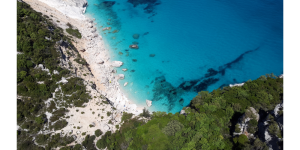
Italy, surrounded by the sea
What is certain is that the sea surrounds Italy. Of its twenty regions, only five – Valle d ‘Aosta, Lombardy, Piedmont, Trentino Alto-Adige and Umbria – do not overlook the sea. For the rest, it is immersed in the Mediterranean Sea.
The Mediterranean Sea: the middle ground
And I start, as I often love to do, from the word’s etymology: Medius and earth, the middle earth. The name of the most historically crucial European sea, the most evocative, is a name that does not carry water. Mesopotamia was called Mediterranean, in the sense of continental, a term opposite to maritime. The Mediterranean Sea is a sea surrounded by land. As its meaning says, it is in the midst of the earth. It bathes several states: European, African, and Asian. Italy is at the centre of this earthly enchantment.
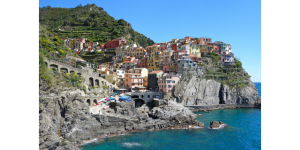
The Mare nostrum
The Mare nostrum, as the Romans called it, takes various names depending on the latitude. And so, Italy is bathed by: the Adriatic Sea, Ionian Sea, Tyrrhenian Sea, Ligurian Sea, Sea of Sicily, and the Sea of Sardinia.
I discuss the Italian coasts’ characteristic and unmissable areas starting from these six seas.
The Adriatic Sea and the Romagna Riviera
If we talk about the Adriatic Sea, we can only speak about the Romagna Riviera, an irreplaceable icon in the youthful imagination of revelry and attractive excesses.
The Romagna Riviera stretches along the coasts of the Upper Adriatic for about 90 kilometres, starting – from the north – of the province of Ravenna, passing through that of Forlì-Cesena and ending at that Rimini. The boundaries are to the north of the province of Ferrara and the south of Pesaro-Urbino, in the Marche region.
The beaches
The coastlines are sandy and wide; the sea is easily practicable due to the shallow seabed and the slow gradualness of its depth. The beaches are very clean, the sea a little less, especially for the massive crowding and the sandy seabed and complete, in the most fallen months, of algae. The beaches of Romagna are very suitable for families because they offer services of all kinds and activities for all tastes.
The organization
The organization is often perfect, the receptivity high, even for the vast flat spaces behind. Many are hotels, restaurants, and bathrooms – as they are called here. Emilia-Romagna has welcomed Italian and foreign tourists since the sixties; it is a privileged summer destination for those who love to receive various and impeccable services at affordable prices. The hospitality and entrepreneurial skills of Romagna are remarkable.
Il Ravennate
Punta Marina and Marina di Ravenna
Punta Marina and Marina di Ravenna are the marine resorts of Ravenna.
More about Ravenna. Very well known in Marina is the Hana-Bi, a lido where they are located; in addition to a wide gastronomic offer and several sports fields, it is among the best summer music offers of concerts and DJ sets.
Cervia
Cervia is known for its salt (the first traces written on the salt flats – first Ficocle – date back to the tenth century) and for the hospitality given to Grazie Deledda – one of the two Italian women to have won the Nobel Prize, together with Rita Levi Montalcini -, who spent her summers there and where she wrote some of her novels, including “La fuga in Egitto”.
In Milano Marittima
Then there is the “Garden City” of Milano Marittima, born in 1912 and destined for elite tourism and then became one of the destinations of chic and fashionable nightclubs and discos.
The Cesenate
Cesenatico
The port channel of Cesenatico was built at the beginning of the fourteenth century to give a view of the sea to the city of Cesena. It is delicious and constitutes the axis around which the centre of the town stands, with restaurants and bars that overlook it and make an already suggestive view even more pleasant. You can also visit the Maritime Museum there.
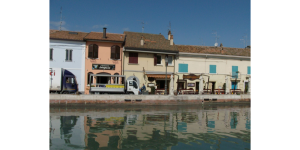
Rimini
Then there is Rimini, the provincial capital city – with interesting Roman monuments: the Tiberius Bridge and the Arch of Augustus – which stands right on the sea and has been flooded by tourists since spring.
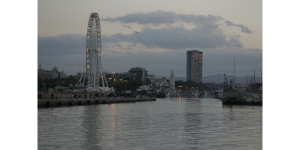
Riccione and Cattolica
Riccione and Cattolica close the coast of Romagna. Both are very nice (in Cattolica, there is a beautiful theatre, the Teatro della Regina, designed in 1884 by Cervellati), well maintained and are places to eat excellent fish. Very famous, especially in the eighties and nineties, the Cocoricò of Riccione, a discotheque born in 1989 and a destination for tourism of young people from all over the peninsula, a sort of temple of the night.
The beautiful cycle paths that partly run along the sea and up to the hills are noteworthy.
Read also: https://in-italy.eu/in-giro/pasquetta-in-emilia-romagna-luoghi-e-cibi/
Abruzzo
Going south, it is mandatory to mention the approximately 40 kilometres of Abruzzo coast between Ortona and Vasto with the wonderful – and now finally known – overflows (the overflow was an ancient fishing machine of the central-southern Adriatic). As you “go down”, the number and size of the beaches progressively decrease, the beaches shorten, and the human presence even a little dull.
Between the Adriatic Sea and the Ionian Sea
And then, there is Puglia, known above all for Salento.
Adriatic Salento: Otranto and Santa Maria di Leuca
Salento has almost 200 kilometres of coastline and is washed by the Adriatic and Ionian Seas. The Salento Sea is sometimes Caribbean. On the Adriatic side, the most famous places are undoubtedly Otranto – with its wonderful cathedral (founded in 1068) that combines the early Christian, Byzantine, and Romanesque styles and, in the rose window, Gothic, its precious mosaics -and Santa Maria di Leuca, where the two seas meet and from whose lighthouse the two currents can sometimes be distinguished.
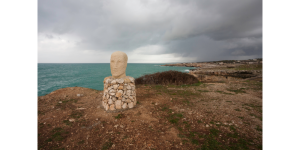
The Ionic Salento
The Ionian Salento is known for several places, among which stand out: Torre Vado, Gallipoli – khalé polis, is a beautiful city, in Greek -Porto Selvaggio and Punta Prosciutto.
Torre Vado
Torre Vado is between Leuca and the Maldives of Salento, and its coastline is characterized by the alternation between low and rocky cliffs and fine sandy beaches, both free and equipped, and a small port from which stands a beautiful tower of the sixteenth century.
Gallipoli
Gallipoli has a coastline of about 20 km. The wonderful centre is composed of the old town on a limestone island connected to the mainland with a seventeenth-century bridge and the village, which welcomes the most modern part of the city. There have been an impressive number of tourists in summer for some years.
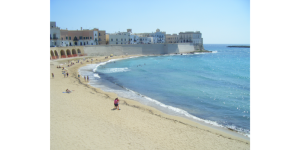
Porto Selvaggio
Porto Selvaggio has a 1,100-hectare park, a marine protected area where there are even Aleppo pines. In addition, you can visit the so-called Swamp of the Captain, a body of water where currents of seawater and fresh and cold groundwater water coexist, probably created due to the sinking of an ancient cave.
Punta Prosciutto
On the border between Lecce and Taranto is Punta Prosciutto, which has rockier areas to the north and a long strip of white sand to the south. Its transparent and shallow sea makes it perfect for those who love to snorkel.
The hospitality of Salento
The expanses of the olive trees, the delicious food (pastries, fish, wines), the festivals of folk songs and dances – the pizzica – born in Salento-, the tarantula – typical of different regions of Magna Graecia and also widespread here –, beautiful places (you can not forget the splendid baroque of Lecce) and hospitality that has become good and excellent levels in recent decades make Salento a coveted and often overbooking destination, in July of August.
Tyrrhenian Sea
Continuing, ideally, along the boot, you pass through the painful beauty of Calabria – how not to mention Tropea with its ravines – and, going up the Tyrrhenian Calabrian coast, you reach Maratea, which can be said to be the southern outpost of Cilento, even if it is not part of it, being in Basilicata.
Maratea
It is, in fact, Maratea, the only Tyrrhenian Lucanian view. As reported by a plaque in the town’s main square, it is the “City of 44 Churches” – there are, in addition to the historic centre, numerous hamlets in each of the others. The historic centre of Maratea is really lovely and well maintained, halfway between the sea and the Christ.
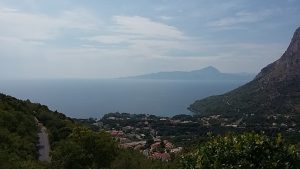
Christ the Redeemer
Maratea is known above all for imposing Christ the Redeemer on top of Mount San Biagio. The statue, erected by Florentine Bruno Innocenti between 1963 and 1965, is visible from all the countries of the Gulf of Policastro and does not look towards the sea, but towards the interior, towards the hamlet of San Biagio, to protect the inhabitants. It replaced an old cross built to commemorate the resistance of the marathon against the French in 1907. Since 2013 there is also a twinning with Rio de Janeiro’s best-known Christ, the Redeemer.
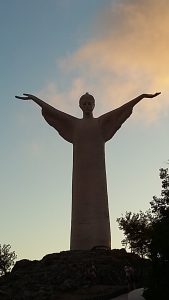
Port of Maratea)
A jewel is a port, where beautiful boats are docked, there are fish restaurants, “Za’ Mariuccia” -ice cream parlours, clubs, and shops.
The shoreline
The coast is 32 kilometres long and has 28 beaches – some of the sand, most of the pebbles -dry coves and walls of rocks that plunge into the sea. There’s something for everyone. Each one is lovely.
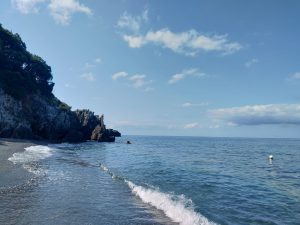
Cesare Pavese, “The Great Fire”
Maratea, among mountains, hills, and ravines, has breathtaking landscapes, among the most enchanting in Italy, landscapes cited for their beauty also by Cesare Pavese in the novel “Fuoco grande”, written in 1946 with the Leucò of the “Dialogues”, his friend Bianca Garufo, and remained unfinished, but published posthumously in 1959. “U focu ranni”, in dialect marathon, is a sentimental or emotional situation difficult and heavy on the heart. The novel is set in Maratea. Pavese writes: “I was breathing that wind that came from far away. Maratea was at the foot of a wild mountain and bathed her houses by the sea. Silvia was that country. How many times he had talked about it? ”
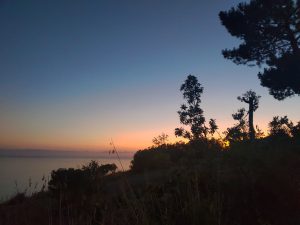
The enchantment of land and sea
The bougainvillaea, the churches, the alleys, the climbs, the grove of olive trees around, the mountain above, the sea below: a timeless charm, with few comparisons.
An unmissable place, not so crowded, with the beautiful sea, perfect for those who love to go by canoe to see the sea caves. The coast is almost as beautiful as that of Cilento, its natural continuation in Campania.
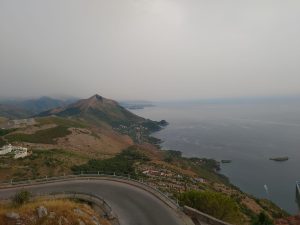
Italian coasts – Maratea panorama from the Christ
The Cilento
Cilento is a large maritime and inland area of the province of Salerno. Cilento has a coastline of a hundred kilometres between the Gulf mentioned above of Policastro up to, going north, the Gulf of Salerno. Since 1991 it has been a protected natural oasis: the Cilento National Park and Vallo di Diano are, in fact, part of the UNESCO World Heritage Site.
Marina di Camerota
You can not leave Marina di Camerota, with its delightful centre and famous for the “lamparata”, this village’s ancient art of night fishing. A goitre and a fishing boat come out: from a streetlight placed on the first, and handled by a “lumista” with mastery, an intense light that moves, attracts and distils the blue fish; from the fishing boat – called cenciola – a net then descends that collects the many fish that, very fresh, will then be consumed. An ancient local ritual, open for several years also to tourists.
Palinuro
Further north, Palinuro, with its beaches of light sand, the Blue Grotto (the same name as that of Capri, yes!), the cliffs of Capo Palinuro, and the beautiful marina. A famous destination was the nightclub Il Ciclope, a lounge dug in the caves in front of the beach, closed for some years due to the difficulty, due to its location between the ravines, in guaranteeing public order and security. Now there’s the Ciclope Beach Bar.

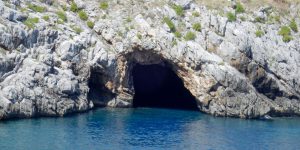
Acciaroli and Hemingway
Further north, we find, among other places, Pisciotta, Ascea, Casalvelino and Acciaroli, a place loved by Hemingway, with a historic centre of medieval origin, colourful houses, the fishing port, crystal clear water and the cliffs on which it gently or impetuously reserves. Between 1950 and 1953, Hemingway stayed here, first in a hotel, then in a house, and most likely drew inspiration from these beauties and fishermen’s tales for his book The Old Man and the Sea.
The Cilento and Vallo di Diano National Park
The Cilento and Vallo di Diano National Park is the second largest in Italy (180,000 hectares, 80 municipalities, eight mountain communities, and archaeological sites) and extends from the Tyrrhenian coast to the foot of the Apennines of Campania and Lucano. It has an extraordinary variety of landscapes and fauna. There are several itineraries to follow, a Network of Museums with more than 20 small realities laboratories of the local culture and civilization of the Park, events and cultural initiatives. The offer of farmhouses, B&B is good. This pearl of Campania is worth discovering.
Paestum
The Greeks
I am close to Paestum, an ancient and extraordinary site. The city was founded around 600 BC by the Greeks – it seems Doric from Calabria – and called Poseidonia in honour of Poseidon (Neptune, for the Romans), god of the sea. The Greek colonists erected the Basilica (550 BC), the Temple of Ceres (about 500 BC) to the south, and the Temple of Neptune (450 BC) to the north, which for its majesty, is to be considered an authentic masterpiece. At the end of the XIX century, the population of Lucani occupied BC, and the name was Paistom.
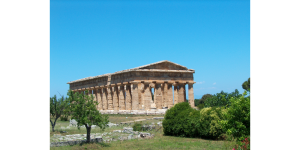
The Romans
In 273, it became a Roman colony and took the name of Paestum (called Pesto until 1926). Thanks to the Romans, the Forum was born, the amphitheatre was built, the Temple of Peace was built, and the urban sector received a considerable contribution. It is of Roman origin. The walled perimeter still exists, consisting of about 5km of defensive walls. All the streets were paved, the houses modernized, and the sacred buildings of the Greeks remained intact. To be noted in these areas (Paestum, Capaccio, Battipaglia) is the renowned buffalo mozzarella DOP.
Read also: https://in-italy.eu/in-48-ore/week-end-a-ischia/
Ligurian Riviera olive oil,Riviera Ligure
We now move north to learn about the marine wonders of the Ligurian Sea.
The Cinque Terre is known everywhere in the world: five small, picturesque villages, which seem to be carved into the hill or rock, the Cinque Terre, Monterosso, Vernazza, Corniglia, Manarola and Riomaggiore, are located in the province of La Spezia, east of Liguria.

Cinque Terre National Park
The Cinque Terre National Park is very small but has the highest population density: about 4,000 people live in the five municipalities. Humans have modified the slopes of the hills to obtain cultivable parts – called ciàn– maintained by dry stone walls and is a World Heritage Site.
Animals and plant life
As fauna, there are, at the bottom, holm oaks, different shrubs, and aromatic species such as rosemary, thyme, helichrysum and lavender. There is also the caper; chestnut groves and oaks are at higher altitudes. As a flora, there are royal gulls and many small birds, rodents, and reptiles. In 1997 the Marine Protected Area was established for the Municipalities of Riomaggiore, Vernazza, Monterosso and for a small portion of Levanto, considered the “sixth land”.
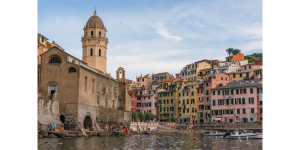
The five villages are delightful, with Genoese tower houses and all on the sea, between cliffs and headlands that creep in, except for Corniglia, which is a little high.
The paths
There are two paths, number 1, called Alta via delle Cinque Terre, an ancient mule track, a ridge path that allows you to reach the Cinque Terre through secondary paths, and path no. 2, the Blue Path that includes the famous stretch overlooking the sea called the Way of the Gods.
The Park of Portofino
Liguria is also known for the Portofino Park, whose end in the most suggestive sea is San Fruttuoso, reachable on foot from the top of the Park from the localities Ruta di Camogli or by ferry from Santa Margherita Ligure, Portofino and Camogli.
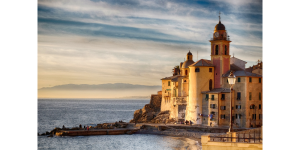
San Fruttuoso
In San Fruttuoso is the abbey of the homonymous Catalan bishop, whose ashes – says the Catholic passio – arrived by sea from Spain, where San Prospero would transport them following the Arab invasion of Spain. Fruitful – it is claimed – he was killed in Tarragona in 259 AD because he refused to worship the Roman emperor and did not deny his Christian faith – at the time, Rome was an enemy of Christians.
The tower, the bay, the hospitality
There is also a tower built by the Dorias, a patrician family who participated in Genoa’s commercial and economic development. And the small bay of San Fruttuoso also offers places to refresh and some rooms to sleep. Inside the Park, there is a delicious agri-refugee – reachable from the mountain, that is from Ruta di Camogli, or San Fruttuoso – strictly on foot – which offers food and hospitality for walkers and, in general, for those who love silence, nature, the sea, the sensory upheaval of a breathtaking panorama.
Sardinia
Facing the Ligurian coasts, beyond Corsica, is the first of the two large Italian islands, Sardinia, the Italian region with the most kilometres of coastline (about 1,800). Selecting between so many seas is difficult.
Stintino – Sassari
Starting from the North West, in the province of Sassari, I point out Stintino, a peninsula with an incredible sea in front of the Asinara Park. The glossy sand, the transparent and shallow sea has to the east in Pelosa and Pelosetta the most famous beaches, while to the west there are rocky coves; in the salinas, instead, you can surf. In addition, there is a brackish oasis where you can observe pink flamingos.
Alghero – Sassari
The City
Further south, still in Sassari, is Alghero, founded at the beginning of the twelfth century by the Doria mentioned above. In 1350 it came under Catalan-Aragonese control first, then Spanish, and its architecture, with numerous towers inside and outside the city and the ramparts, are historical-artistic evidence of this. Catalan expressions are also found in the language: Alghero is considered a Catalan language enclave. The historic centre is beautiful; the port is wide and dynamic, and the beaches are beautiful.
The sea
Being a karst place, there are ravines and caves, many of which are still unexplored because they can only be reached by sea. In some areas, you can snorkel. Many beaches can be reached via cycle paths. Of note is the beach of Lazzaretto and Bombarde to the north of Porto Ferro to the south.
In Alghero, it seems to listen to the incredible voice of Giuni Russo in his streets and dreams.
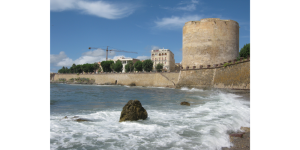
Cagliari
Moving south, you arrive in Cagliari, the region’s capital, with a Phoenician foundation and Carthaginian history. A very ancient city, in short, with parks, sanctuaries, churches, a fortified citadel and a fine castle, and very well-known beaches. Mention the Poetto beach, a coastline eight kilometres long where you can admire the beautiful tower (poet could derive from a poet or the port), go water skiing, and devote yourself to nightlife.
Villa Simius
About 40 kilometres away is Villa Simius, a beach with transparent water and reflections of colours enclosed in a dense bay of Mediterranean scrub that protects it from the winds.
Cala Luna – Nuoro
To the east, in the province of Nuoro, is Cala Luna (Elune, in Sardinian). The name seems to have been given by the shepherds because of the difficulty in reaching it and the consequent consideration that it was distant like the moon. It is reached by land or sea and is a paradise because it is not crowded. A few kilometres away, there are sea caves with stalactites and stalagmites. Cala Luna was the set of the 1974 film “Overwhelmed by an Unusual Fate in the Blue Sea of August” by Lina Wertmüller, starring Giancarlo Giannini and Mariangela Melato.
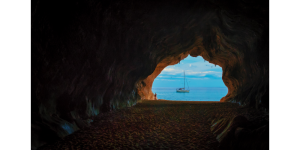
The Maddalena Archipelago – Sassari
The archipelago of La Maddalena, the northeastern tip of the island, is part of the homonymous Park and includes several islands: in addition to the Maddalena, also, the one also known as Caprera. The first human traces date back to the Neolithic era; it remained almost depopulated until 1767, when a military district was established there. Napoleon was arrested at the Maddalena in 1793, while in Caprera, Garibaldi lived about seventy years later. Today the island is a privileged tourist destination for those who love unspoilt nature, vast spaces, wind, and crystal-clear water.
Sicily
Trinacria is the largest island in the Mediterranean and second in Italy, in terms of kilometres of sea, to Sardinia: it is surrounded by 1,639 km of coastline. Even here, it is difficult to choose the most significant places.
Taormina – Messina
Greek settlers founded Taormina in the 4th century BC under the name of Tauromenion, and the agora, theatre and acropolis were then built. The magnificent Teatro Antico was built in the third century BC (and then several times arranged, modified, and enriched), taking advantage of the morphological structure of the hill where it resides that offers a view of the sea and also, at one end, the view of Mount Etna. To govern the city were Romans, Byzantines, Arabs, Normans, and Spaniards.
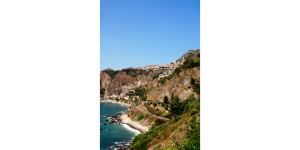
Characters are known in Taormina
Its landscapes and architectural riches have attracted the likes of D.H. Lawrence, André Gide, Quasimodo, Liz Taylor, Greta Garbo, the poet Anna Achmatova and many others.
Isola Bella and Giardini Naxos
Suggestive, in the bay of Naxos is the small Isola Bella – the name was given to it by a German aristocrat -a tongue of sand that connects the mainland to an islet. The Naxos Gardens are an archaeological park of great importance, with citrus groves and palm trees, remains of temples and walls. There is also the Schisò Castle, a charming fortress located a few steps from the beach of Giardini Naxos.
Aci Trezza – Catania
Going south, ten kilometres after Catania, we find Aci Trezza, the inspiration for the novel “I Malavoglia” by Giovanni Verga. Here are the famous stacks of the Cyclops, those that – according to legend – Polyphemus threw at Ulysses, who had blinded him without catching him, and who sank on its shores. Worthy of mention is the Norman castle of Aci Castello.
Porto Palo di Capo Passero – Siracusa
In the province of Syracuse, at the extreme southern tip of Italy, surpassed only by Linosa and Lampedusa, there is Porto Palo di Capo Passero. Inhabited since ancient times, for its centrality in the Mediterranean and its crops, it passed under the Arabs – it was inhabited by the Berbers who gave it the name of Capo Pachino. Subsequently, with the departure of the Arabs, it remained almost uninhabited until it was repopulated in 700 thanks to the noble Barons of Noto.
La tonnara
Gaetano Moncada had houses built near the historic tonnara and changed its name to the current Porto Palo. From there, the country expanded and enriched, and tuna remained in business until the 1920s, when the new production systems made it obsolete. Today Porto Palo has become a delightful village kept very well where visitors can see a blue sea that tends to infinitely.
Scicli – Ragusa
In the province of Ragusa there are the beaches of Scicli – a very suggestive baroque town -: the beach of Sampieri, very long and well equipped, and that of Donnalucata, with fine sand, splendid sea, lots of free and little anthropized beach.
Eraclea Minoa – Agrigento
In Agrigentino splendid – although in recent years eroded by the tides – is the pine forest of Herraclea Minoa. The ancient city of Heraclea Minoa – probably founded by the Selinuntini – extends on a white cape towards an enchanting sea landscape. The origins of Minoa sink into the ancient myth of the expedition of Minos to Sicily on the traces of Daedalus, the labyrinth architect, who fled in flight with wax wings together with his son Icarus.
Selinunte – Trapani
Unmissable, further west, Selinunte. Founded in the 7th century BC on a plateau 30 meters above sea level, it is located in the largest archaeological Park in Europe. It is an acropolis of embarrassing majesty lapped by the sea. There are seven Doric temples, a style that, more than others, conveys the sense of essentiality and naturalness, characteristics of the immortality of divinity. Then there are shrines and altars. A view so wide and moving that it escapes the physical and emotional reach of the eye.
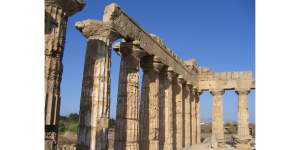
The natural reserve of Zingaro
Further north, still in the Trapani area, between San Vito lo Capo and Scopello, the Gypsy-oriented Nature Reserve extends for seven kilometres. You can visit, with dinghies for hire, the seven coves. In addition, there are both marine and terrestrial caves.
Scopello – Trapani
Scopello is a jewel of the seventeenth century known for its stacks and the delicious “pan cunzato”. There is also a beautiful and ancient tuna fishery, perhaps from the 12th century.
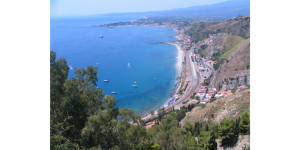
Terrasini, Isola delle Femmine, Mondello – Palermo
In the Palermo area, you will be surprised – apart from the city, which lives by the sea and in the sea – the cliffs and the red sand of Terrasini – by sinus land, the land of the coves -, the Isola delle Femmine – with its beautiful beaches not taken by storm by tourists -, the famous Mondello, the wide and welcoming Palermo beach.
Sicily enchants with its stratified millennial history, its colours, and its intense and rich tastes, with a warmth not only climatic but with architecture and amazing landscapes.
The rest of the Italian coast
I moved following the six seas that make up our Italian Mediterranean, varied, fascinating, moving, and intriguing, in an ideal tour around Italy, not exhaustive. There are, in fact, the islands of Sicily, from Aeolian to Egadi to Pantelleria and Ustica. There is the Amalfi Coast. But this, like that of many other Italian seaside resorts worth telling, is another story, certainly to come!


